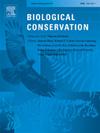Measuring forest degradation via ecological-integrity indicators at multiple spatial scales
IF 4.9
1区 环境科学与生态学
Q1 BIODIVERSITY CONSERVATION
引用次数: 0
Abstract
Forests harbor some 80 % of Earth's terrestrial biodiversity and play a crucial role in sequestering and storing carbon that is linked to their ecological integrity and biological diversity functions. Forest degradation—the loss of forest-ecosystem integrity measured by changes to native-species composition, functional processes, and keystone structures—is a major source of emissions and significant cause of biodiversity decline. Addressing this loss is critically important for fulfilling the Paris Climate Agreement and the Kunming-Montreal Global Biodiversity Framework. Additionally, the United Nations (2021a) Strategic Plan for Forests 2017–2030 calls for a halt to both deforestation and degradation by 2030. However, many countries, particularly in the Global North, fail to fully acknowledge forest degradation as a problem within their own borders, and countries are not presently on track to meet the 2030 deadline. Building from established literature, we propose a principle, criteria, indicator and verifier (PCIV) approach that would enable monitoring of degradation at various scales, ranging from the loss of large, old trees to intact landscapes relative to reference conditions derived from primary, mature, historic, and semi-natural conditions. Degradation drivers include multiple forms of commercial logging and road building that alters native species composition, structure, and functionality. Case studies from three major forested biomes (temperate, boreal, and tropical) illustrate the geographic extent and types of degradation. We highlight an urgent call for countries to better detect and assess the cumulative damages of forest-degradation and to end it as promised.
求助全文
约1分钟内获得全文
求助全文
来源期刊

Biological Conservation
环境科学-环境科学
CiteScore
10.20
自引率
3.40%
发文量
295
审稿时长
61 days
期刊介绍:
Biological Conservation is an international leading journal in the discipline of conservation biology. The journal publishes articles spanning a diverse range of fields that contribute to the biological, sociological, and economic dimensions of conservation and natural resource management. The primary aim of Biological Conservation is the publication of high-quality papers that advance the science and practice of conservation, or which demonstrate the application of conservation principles for natural resource management and policy. Therefore it will be of interest to a broad international readership.
 求助内容:
求助内容: 应助结果提醒方式:
应助结果提醒方式:


